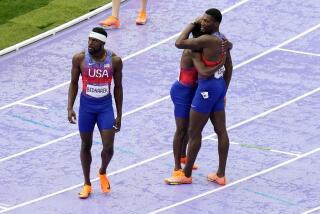Hard Part for U.S. Track Athletes May Be Making Team
- Share via
INDIANAPOLIS — No matter what happens at the U.S. Olympic Trials July 15-23, the United States is assured of taking a formidable track and field team to Seoul.
The Americans have numerous medal contenders among their sprinters, hurdlers, long jumpers and triple jumpers. So many in fact, that some will be left off the team because each nation is allowed only three track and field athletes per event (four for each of the two relays) at the Olympics.
Other athletes at the trials at the Indiana University Track and Field Stadium will have a tougher time making the Olympic team than winning a medal in Seoul.
Consider some of the men’s events and who will be vying for spots on the team:
In the 100 meters, Olympic champion Carl Lewis leads a group of five Americans who ranked in the top 10 in the world last year.
Lewis and world champion Calvin Smith ranked 1-2 in the 200 meters and four other Americans made the top 10. Butch Reynolds was one of four American 400 meters runners in the top 10.
In the 110-meter hurdles, two-time world champion Greg Foster and Tonie Campbell ranked 1-2 but Foster, silver medalist at Los Angeles, became a question mark on July 4 when he fell during a routine warmup drill at Cal Poly Pomona and broke his left arm. The injury could keep him out of the trials.
Four other American hurdlers were in the top 10, and neither world-record holder Renaldo Nehemiah nor Olympic champion Roger Kingdom made that list because of injury.
“For the hurdlers, we’d better get ourselves moving,” Foster said before his injury. “Overall, I think we’ll have a great team. The system we’re facing is tough. In the 400, you have to run 44 seconds just to get out of the first heat. It’s ridiculous. There’s more pressure in the Trials. Just to make the team, you’ve got to kill yourself. Anything can happen between July 15 and September.”
Edwin Moses and Danny Harris, who snapped Moses’ nine-year winning streak last June, lead five Americans in the top 10 in the 400-meter hurdles.
Four Americans, again led by Lewis, were among the top 10 in the long jump, while World silver medalist Mike Conley was one of three triple jumpers to crack the rankings.
Lewis likely will compete in three events at the Trials, but a scheduling problem in Seoul could make it difficult for him to attempt repeating his 1984 four gold-medal performance.
The second round of the men’s 200 meters and the long jump final are scheduled to begin five minutes apart. Unless the Olympic schedule is changed, Lewis will forsake the 200.
Like the men, the U.S. women will have fierce competition in the sprints and hurdles. Unlike the men, American women do not dominate the world rankings but they will produce some Olympic medal contenders.
Two of the more interesting situations in the women’s sprints will be the efforts of Evelyn Ashford and Valerie Brisco, the two stars at the ’84 Games, to make the team. Both struggled last season.
Ashford, the world record holder and Olympic champion at 100 meters, was plagued by hamstring injuries and she failed to make the World Championships team.
Brisco, who won three gold medals in Los Angeles, did not qualify for the open 400 meters at the Worlds, but she did run on the 1,600-meter team that won a bronze in Rome.
Two other women to watch will be Mary Decker Slaney and Jackie Joyner-Kersee. Slaney, competing for the first season since 1985, plans to double in the 1,500 and 3,000 meters. She is aiming for a comeback in the 3,000 in which a tumble at the ’84 Olympics cost her a chance for gold.
Joyner-Kersee, widely considered the best female athlete in all track, will double in the heptathlon and the long jump. She holds the world record in the heptathlon and held the world mark in the long jump until it was broken this spring. She is always a threat to break records in both events.
More to Read
Go beyond the scoreboard
Get the latest on L.A.'s teams in the daily Sports Report newsletter.
You may occasionally receive promotional content from the Los Angeles Times.






